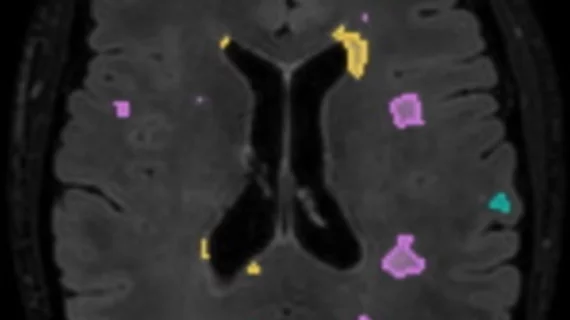AI assistance helps rads shave 1/3 of their reporting times for MS lesions
Artificial intelligence-based software can significantly cut back on interpretation times for radiologists assessing lesions in patients with multiple sclerosis.
In fact, AI could help radiologists reduce their reporting times by up to one-third with the help of AI, according to new data in the European Journal of Radiology.
MS is a common inflammatory autoimmune condition that causes patients to develop lesions of the brain and spinal cord. These lesions can be visualized on MRI and are integral in both diagnosing MS and understanding its potential progression, though doing so is a time-consuming process.
“Due to the high number of MS patients and the important role of MRI during the whole disease course, MRI examinations of MS patients constitute a considerable part of the workload in daily clinical routine,” corresponding author Sönke Peters, with the department of radiology and neuroradiology at University Hospital of Schleswig-Holstein in Germany, and colleagues explained. “A fast and reliable support in evaluating such MRI examinations is therefore of interest for radiologists.”
Easing the burden of lesion assessments has been a target of multiple AI vendors, the authors noted. For this study, the team tested the effects of mdbrain—a lesion detection software.
The team had four radiologists count the MS lesions of 50 patients without the software first, repeating the assessment six weeks later with the help of AI. Reporting times were then compared for both the initial assessments and follow-ups (when readers looked for new or enlarging lesions).
AI assistance reduced reporting times for determining lesion load from 286.85 seconds to 196.34 seconds. Times for follow-up assessments decreased from 196.17 seconds to 120.87 seconds, with no significant differences in performance between the AI software and readers.
The software’s benefit varied between users, with the least experienced recording the largest differences in reporting time using AI assistance.
Though the software was proven to save radiologists time, there are more factors that the research did not consider but that hold equal value, the team indicated.
“Besides the direct effect on reporting times, as investigated in this study, a good integration into the routine workflow is crucial to benefit from a supporting tool for image analysis," the group noted, adding that this, in addition to a cost analysis, are both necessary prior to clinical implementation.
Learn more about the research here.

